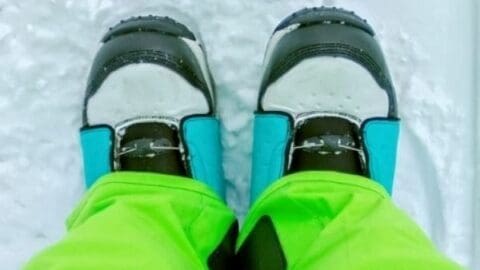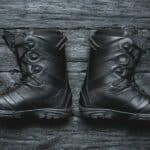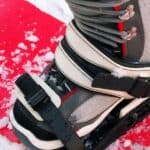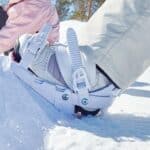Do new snowboard boots need breaking in? Well, the thing is, each snowboard boot is unique.
Each brand and model has its unique characteristics.
This means that whether a boot needs breaking-in, and if so, how much breaking-in, is an impossible question to answer without knowing a lot more about the boot.
Table of Contents
How to Break in Snowboard Boots
The way to break in your all-new snowboard boots is: wear them around the house! Wear the number of socks you intend to have out in the snow when breaking in your boots at home. Wear the boots for several hours a day, for several days, until they are a comfy fit.
Boots with Heat-moldable Liners
Except for cheaper brands, most boots come with heat-moldable liners.
If you’re just about to buy snowboard boots, you’ll thank me if you follow my advice and ensure that any boots you get have heat-moldable liners.
Tip: When inspecting prospective boots, pay special attention to their liners.
The outer parts of boots crack and wear over time, but they last much longer than the liners, so the quality of the liners more or less determines the quality of the boots.
Self Mold or Store mold
It is possible to mold heat-moldable to your feet either by yourself or in a store.
Mold the Boots to your Feet yourself
It is possible to ride many brands and models of boots into the comfort zone in just a few days – but there’s a ‘gotcha’ here to watch out for: the better the quality of the boots, the longer they will take to ride in.
Better quality boots are stiffer and come with high-quality liners, meaning that riding them in takes a bit longer.
Boots that ride in quickly indicate that they are made from cheaper, more flexible materials and come with low-quality liners.
Tip: To a certain degree, you can ride-in boots that aren’t heat-moldable.
Mold the Boots in a Store
It can take a while to ride in snowboard boots, and let’s face it, not all of us are paragons of patience. It is possible to fast-track the molding process by taking the boots to a store.
In the store, the technician will remove the footbeds and heat up the liners.
After returning the footbeds, the technician will direct you to put your feet into the boots and do them up the way you would normally.
He or she will then have you stand as you would on your snowboard for about 15 minutes.
The technician will make adjustments for you wherever the boots feel like they’re ‘pinching’. Don’t be afraid to speak up, because it’s best to get it right in a single visit to the store.
Tip: Many – perhaps even most stores will heat-mold your boots for you for free.
However, if the store charges for it (and you’re broke, or you’re just some kind of Scrooge, tut, tut), you ought to be able to sort it out by yourself at home.
I’ve included a footage in this link to show you how this step’s done.
Nuisance Socks
Actually, it’s not the socks that are a nuisance, it’s that you bought your boots without first slipping on the socks that you usually wear.
So now you’ve ridden your boots, heated the life and times out of them, and they still cotton pickin’ pinch. What to do?
The options aren’t great, I’m afraid. They boil down to:
- Use fewer pairs of socks if you normally wear more than one pair.
- Use thinner socks until your boots become more comfortable. I’m not suggesting that you court frostbite! Don’t come whinging to me if you can’t use your common sense here, fella.
Tip: Speaking of socks, there are socks made specifically for snowboarding. They are specially strengthened in all the areas that are important to snowboarders and they come complete with custom-built cushioning.
Does this Fit: Let’s See
EZ Fit
If you are a casual skier or just starting out skiing, you don’t need to go nuts with a tight fit. For the EZ fit, when you’re standing straight up, your toes should touch the boot.
On the other hand, your toes shouldn’t touch the boot when bending forward. No matter what, don’t go bigger than this size.
Optimal Fit
This is the right fit for anyone serious about balancing comfort and performance.
Toes should touch the boot when you are standing straight up, but be hardly touching when you bend your knees.
Max Fit
This is for the high-performance crowd for whom comfort is a dirty word. Toes need to be touching the front of the boot when standing up straight and when bending the knees.
Tip: Max fit isn’t at all comfortable when you’re not skiing, so undo the bottommost couple of buckles when you’re just walking around.
Frequently Asked Questions about How to Break In Snowboard Boots
How can I be certain to buy boots that will puff out and eventually become comfortable?
The best way is to buy boots that are snug, but under no circumstances, cause pain or numbness. Boots that do that may be limiting the flow of blood to parts of your feet! Have on the same socks you normally would out on the snow and test the new boots in the store before paying a dime.
Can you recommend the best snowboard boots ever?
The same boots will wear differently on different folks. However, when you walk into a store to buy snowboard boots, try out several different brands and models. The more boot pairs you try on, the better understanding you’ll have (like a ‘feel’) for the sort of boot that works best for you.
How much ‘give’ can I expect from my snowboard boots?
Assuming a breaking-in period of around two weeks for an average amount of skiing, most boots will stretch between a quarter and three-quarters of an inch longer and wider.
Afterword: How to Break In Snowboard Boots
Break-in snowboard boots by riding them around the house and out in the snow. Accelerate the process by heat-molding them either at home or in a store.
Choose the right sort of fit for your level of experience and aspirations.
Enjoy the slopes, and stay safe!




